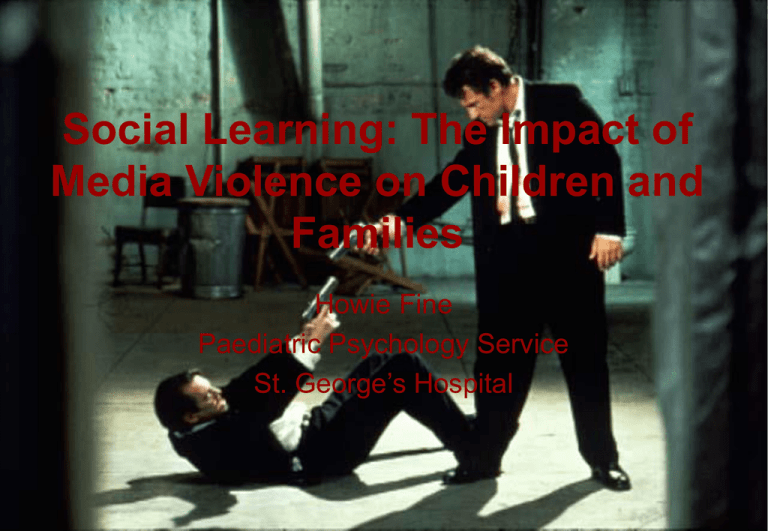The Impact of News and Entertainment Media Violence on Children
advertisement

Social Learning: The Impact of Media Violence on Children and Families Howie Fine Paediatric Psychology Service St. George’s Hospital 1 Types of Violence in the Media 1. 2. 3. 4. Violence with a weapon Violence without a weapon Crashes and explosions Verbal violence 2 By the time the average American child graduates from elementary school, he or she will have seen more than 8,000 murders and more than 100,000 other assorted acts of violence (e.g., assaults) on television (APA, 1992). 3 National TV Violence Study (1996-1998) • 8,000 hrs of TV analysed • 60% of programmes were violent. • “Good” characters perpetrated nearly 40% of the violent acts. • 40% of the violent acts perpetrated by “bad” characters went unpunished. • 75% of the perpetrators showed no remorse. • Over 50% of the victims showed no pain or suffering. 4 National TV Violence Study (1996-1998) • 35% of victims experienced unrealistically low levels of harm. • 15% of the violent programs portrayed longterm consequences (e.g., to the victim’s family). • 50% of the violent scenes were lethal, 40% were portrayed as humorous. 5 What makes observational learning more likely? Repeated exposure is the #1 factor! However, the effects of media violence may be increased or decreased by: – Characteristics of the individual viewer and the environment – Characteristics of the media presentation and how the viewer perceives it 6 Individual and Environmental Risk Factors Age: Media violence affects children aged 211 the most Gender: Media violence affects both boys and girls Family: Co-viewing, discussion, and antiviolence norms reduce effect Cultural and gender role norms: Can reduce or increase effect 7 Individual and Environmental Risk Factors Existing Aggressiveness: Media violence affects aggressive and non-aggressive children Intellectual ability: Media violence affects both high and low IQ children Social class: Media violence affects upper and lower class children, but lower class children watch more media violence 8 Characteristics of Program that Affect Risk Identification with aggressor: Effects are larger for violent behaviors committed by charismatic heroes with whom the viewer identifies Perceived realism of aggression: Effects are larger when violent shows are perceived as telling about life like it really is 9 Characteristics of Program that Affect Risk Consequences of aggressive act: Effects are larger when aggressor is “rewarded” for his/her actions Justifiability of aggressive act: Effects are larger when aggression is portrayed as justified Attention to scene: Effects are larger when viewer’s attention is riveted on scene 10 Fifty Years of Studies Conclusion “… the causal relationship between [exposure to] televised violence and antisocial behavior is sufficient to warrant appropriate and immediate remedial action… … there comes a time when the data are sufficient to justify action. That time has come.” Jesse Steinfeld, Surgeon General of the United States, March 1972 11 Discussion point • Discuss the relationship between watching television and real-world violent behavior. • What factors may be involved in the relationship between TV and violence/aggression? • Why can't we draw causal conclusions from the results of this research? • If/when you are a parent, will this research guide your parenting and monitoring of your child's TV viewing? How and why? 12






